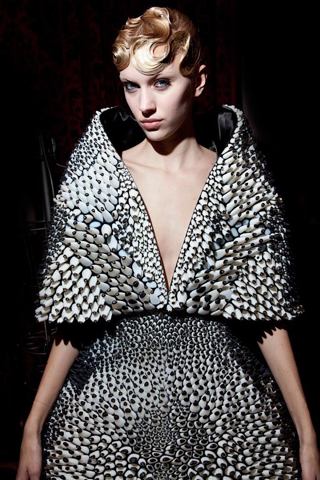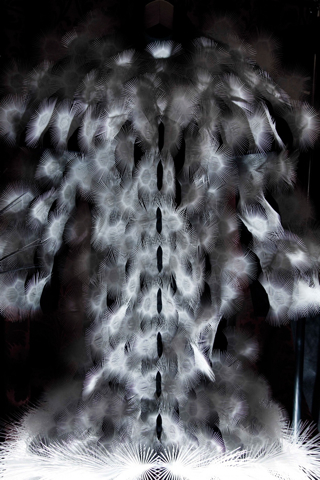Iris van Herpen's Spring Summer 2013 collection showcased at Paris Fashion Week revealed her modern view on Haute Couture, combining fine handwork techniques with futuristic digital technology.
Van Herpen collaborated with artist, architect, designer and professor Dr. Neri Oxman from MIT’s Media Lab, Austrian architect Julia Koerner, 3D print specialist Stratasys and Belgium-based firm Materialise for her latest fashion collection entitled "VOLTAGE".
Her eleven-piece collection featured two 3D-printed ensembles and a gown created with laser sintering.
Stratasys, a leading manufacturer of 3D printers and production systems for prototyping and manufacturing and Materialise, a Belgian-based pioneer in Additive Manufacturing software and solutions, took the opportunity to unveil its 3D printing innovations through the collaboration.
The centerpiece of VOLTAGE was a skirt-and-cape combo lined with thousands of tiny white anemone-like nodules, an intricate dress created together with Austrian architect Julia Koerner, currently lecturer at UCLA Los Angeles, and 3D printed by Materialise, marking the second piece created together with Koerner and the ninth with Materialise.
The 3D printed skirt and cape were produced using Stratasys’ unique Objet Connex multi-material 3D printing technology, which allows a variety of material properties to be printed in a single build. This allowed both hard and soft materials to be incorporated within the design, crucial to the movement and texture of the piece.


"The ability to vary softness and elasticity inspired us to design a "second skin" for the body acting as armor-in-motion; in this way we were able to design not only the garment’s form but also its motion," explains Oxman.
The incredible possibilities afforded by these new technologies allowed us to reinterpret the tradition of couture as "tech-couture" where delicate hand-made embroidery and needlework is replaced by code.

Van Herpen adds, "I feel it’s important that fashion can be about much more than consumerism, but also about new beginnings and self-expression, so my work very much comes from abstract ideas and using new techniques, not the re-invention of old ideas.
I find the process of 3D printing fascinating because I believe it will only be a matter of time before we see the clothing we wear today produced with this technology, and it’s because it’s such a different way of manufacturing, adding layer-by-layer, it will be a great source of inspiration for new ideas.
According to van Herpen, motivation to collaborate with Oxman came after seeing her ‘Imaginary Beings: Mythologies of the Not Yet’ collection – 3D printed by Stratasys’ matchless Objet Connex multi-material 3D printing technology – that featured in the Multiversités Créatives exhibition at the Centre Pompidou, Paris, last Spring.
Oxman explains that the joint venture is very much an extension of the series: "This project has taken ‘Imaginary Beings’ to ‘Wearable Beings’, myths that one can wear. The original collection includes 18 Stratasys 3D printed prototypes for the human body inspired by Jorge Luis Borges' Book of Imaginary Beings. They are human augmentations inspired by nature; but not all wearable.
"For Iris’ collection at Paris Fashion Week it was important to take the series to the next level, thinking not only about form and materials, but also about movement and wearability.
It inspired us to design algorithms that could map physical movement and material behaviour to geometrical form and morphological variation in a seamless and continuous wearable surface.


Julia Koerner explains, "My collaboration with Materialise for the 3D printed dress for Iris van Herpen's Haute Couture Show 'Voltage' 2013 reveals a highly complex, parametrically generated, geometrical structure. The architectural structure aims to superimpose multiple layers of thin woven lines which animate the body in an organic way.
Exploiting computational boundaries in combination with emergent technology selective laser sintering, of a new flexible material, lead to enticing and enigmatic effects within fashion design. New possibilities arise such as eliminating seams and cuts where they are usually placed in couture.
Following the Paris Fashion Show, the skirt and cape will be exhibited at MIT’s Media Lab.































SENATUS Member Comments